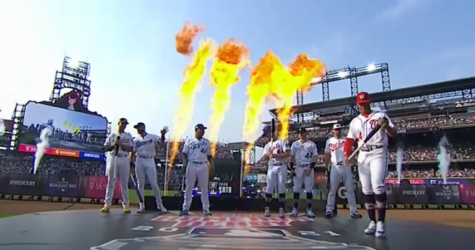
As major league baseball fans remain at the intersection of fickle and the eloquent complexities of profit sharing, “America’s Pastime” is staggering belligerently through another forgettable late night/early morning fortified wine fumes of circular logic. And home runs have plummeted to the level of pre-PED hardball artistry of manufacturing runs in a forested writer’s commune.
While the trajectory of sluggers and pitchers over the last twenty years has been ingrained by echoes of “bigger, faster, and stronger”, the league run by a cantankerous group of eclectic owners has managed to nullify the brute force of subsonic exit velocities and towering launch angles, at least the data shows over the first month of the season. The current battle between genetics and innovative training regiments facing the time-tested will of traditions has been a slaughter, as majestic moonshots mercilessly die at the warning track, and the accusations of altering the baseballs to lifeless specifications are already percolating at the periphery of the brutal front lines.
Through Covid-19 and controversy, the MLB has faced widespread apathy and micro-scandals, such as opting to move last year’s all star game from Atlanta to Denver because of politics, a reckless decision that merited a healthy amount of backlash, as the league tried to monetize on the social justice movement. With the virally popular regular season of the NFL coinciding with the playoffs and the world series, the free-falling ratings are an indication that outside of the sport’s robust core fanbase, viewers on the fence simply don’t resonate with a sport that has not evolved from a comprehensive and optics perspective since the late 1980’s.
Though the league has attempted to implement tweaks to promote parity, especially with the abundance of medium-sized market teams, the strategy has not achieved the desired results, and instead the brand has reached a checkpoint of stagnation, despite a wealth of exciting and generational talent. Enter the shopping center patrons of voracious consumers suddenly transformed into lurid zombies by a brooding team of data scientists and AI handlers, as it’s all about the night of the living dead temperament of the ball. Zombies face a paucity of nourishing brain matter in a society where critical thought is discouraged.
The volatile and brisk nature of April weather aside, the numbers are stunning. Within the context of an age where every statistic is available that piques the imagination, as there’s even a stat that tracks a single player’s interactions on smartphone dating apps in predicting performance proportional to a whether or not the rendezvous with an internet stranger was successful. According to CBS sports, dingers have declined by 35%, since balls peaked in reaching the cheap seats in record numbers during the 2019 season. Teams are now averaging less than one homerun per game, an unprecedented drop in which baseball climatologists claim is another excursion into a “dead ball” era, and the liveliness of baseball, or lack of, corresponds directly to an El Nino or La Nina weather cycle. A little known fact is that within the modern dynamic data driven decision making, one can coexist as a baseball analyst and a meteorologist. However, the ability to multi-task professionally is not helping the exploits of hitters vulnerable to the constraints of the equipment.
Since the golden age of steroids and raw power beginning in the mid 1990’s, and the subsequent fall from grace for Barry Bonds, Mark McGwire, and Sammy Sosa as long ball icons that benefit MLB with record ratings corresponding to the chase to eclipse Roger Maris’s milestone, the league has experimented with humidors to ensure that the game did not reach a decadent video game status of gaudy stats. Keeping the ball moist to prevent unsustainable runs of 10-8 four hour marathons, was first implemented in Denver to offset the effects of thinner air at a mile in elevation. Gradually, through the cyclical nature of 100,000 games the lull in taters is buried in a deep crevasse due to the doctoring of the baseballs combined with the gravitation of pitchers morphed into weight room titans, where a 100 mph fastball is no longer an anomaly. As the larger than defining era of the diamond kings headlined by Mantle and Ruth, along with the fraternizing with celebrities and liberal use of tobacco products, has succumbed to a Zen level of yoga and cutting-edge iso-workouts, the “every man” element of baseball has been extinguished by the force of modernity. It is within this climate where fandom dwindles.
While the longball is still embraced to an extent by the heavily commercialized homerun derby held during all-star week, the days are long gone since phrases such as “chicks dig the longball” sparked ticket sales from demographics outside of the reliable sports aficionado loyalist to the sport. As spending a day at the ballpark is no longer affordable for the average family, and compelling has left the building, unfortunately baseball is no longer relatable to the typical working person.
With the onset of computer simulations, personalities geared towards adhering to the confines their brands, and a rocket blasts regularly falling short of the seats, the zombie balls are doing obscurity’s bidding. Along with zombie researchers influencing in-game decisions based on simulated probabilities and not reality, the culprit of change through strict digital means is not conducive to the future of the urban sanctuary hosting a double-header on an unseasonably furnace blast of a Summer weekday.